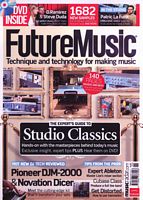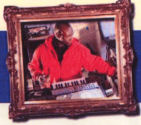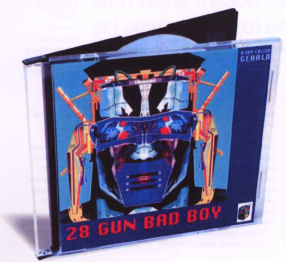| The Classic Album: A Guy Called Gerald - 28 Gun Bad Boy - Juice Box, 1993 | |
 |
Future Music FM230 September 2010 Page: 20 |
Roy Spencer calls for a reload on the story behind the first full-length album of the Jungle era as he speaks to Dance music pioneer A Guy Called Gerald.  Since the 1980s, A Guy Called Gerald has been at the forefront of Dance music. Whether it's providing the meat for early 808 State classics such as 'Pacific State' or pushing us with the pulsating rhythm of seminal cuts such as 'Voodoo Ray', he's been the name to watch and 'wow' over. We join him now, circa '93, at his third album. Again, forever innovating.  A Guy Called Gerald has been on lockdown in his own Machine Room studio in his native Manchester, experimenting with breakbeats. His childhood influences of Reggae and Hip Hop are being taken through the blender and pitched up into bpms that would help to set the benchmark tor a style of music that would be known as Jungle - and become Drum 'n' Bass. The album is the epochal 28 Gun Bad Boy - the first LP of the Jungle generation. A melting pot of styles, wild invention and brave new worlds explored with a trusty sampler, it's considered the defining album that brought the Jungle movement out of the Rave era. To keep his connection to the underground, and to material consistently in the clubs, Gerald had started a Dance sub-label called Subspace with his then-major label home, Sony - but the creaky major just couldn't understand the concept of the white label. "It was a little too underground at the time," says Gerald. "So I decided to just move on and started my own label, Juice Box, and distributed through Deltra." Under his own management, and at his own pace, he was now truly free to push whatever boundaries began to face his wandering mind. Thinking back, Gerald breaks down his situation at that time: "I think the main thing about the 28 Gun Bad Boy album was the feeling of freedom. I'd just been through the restrictive phase with Sony and this was a celebration of freedom." Most of the album's tracks would be released as white labels in short print runs. And when the full album dropped, a large chunk would be mixed in a classic DJ style. "The inspiration for the whole thing was the mix-tape format," Gerald explains. "People were taping DJ sets and I wanted to use that as a concept for the album. As I'd already released a few 12-inches, the idea was to mix some of them into one track for the album." The music itself took on the sound of pure proto-Jungle: Electro stabs, pitched up breaks, swarthy pads, sped-up vocals, bad-boy attitude and a big sense of Rave urgency. It was the sound of now. The club sound. Specifically, the Juice Box parties in Manchester. "For me, that time was the early days of Jungle, and I suppose experimentation was the main influence... Every day was a new musical pathway. We weren't actually thinking of being influenced by any one person. The main influence was the people that were coming to the Juice Box parties we were doing." Gerald estimates that the album sold somewhere in the region of 5,000 - 10,000 copies. "There weren't so many mainstream people interested in that type of Dance music," he says. "There were pirate radio stations and a few underground record shops spread around the UK. There was no press or reviews about the release. It was underground. For the underground." |
|
Track by track with a Guy Called Gerald Mix (Cops/Anything/28 Gun Bad Boy/Sunshine/ Like A Drug/Ses Makes You Wise/Free Africa/King Of The Jungle) "The whole idea of the mix was to showcase the music from my label, as all these tunes had been released over the previous year on my label, Juice Box. "I had a friend, who did a DJ mix for me, by the name of Kurt. I just got the new Juice Box record bag, packed it full of tunes, got in the car and drove over to Cheetham Hill, where Kurt lived. I got to his house, plugged in the DAT machine and Kurt did the mix. I was going to do it myself, but I thought as I'd produced all the tracks, it's hard to hear the music in the way somebody else would hear it. As far as DJs go, Kurt was pretty clever when it comes to sound production. "I started production of the album with this mix track, and I wanted the mix to introduce a flow into the album. As far as I was aware, there had never been a Jungle Techno album before. There had been loads of mix-tapes, so I wanted to have that mix-tape feeling as an intro." Money Honey "I remember being in the studio, the sun coning through the skylight, and having the bass pumped right up. I needed to make a track to express a situation. I'd just finished a relationship and it was the perfect way of expressing the situation. "I would love to break down some of the production techniques, but you don't get nothing for nothing. I was trying out a new technique of sampling - breaking the syllables of the sample into key groups, which made it easier to manipulate the syncopation of how the vocal came across. This was pre me using Recycle. I wanted a deep but funky, skipping kind of vibe. "The drums were all Breakbeat - I would sample breaks and layer them. In those days, you had to personalise your sound to show you knew what you were doing. It was before the days of DJs making music. I don't think the Hip Hop guys had even discovered the MPC60 by then. "I never had to model my music on any other music that was out there. It was part of a series of tracks I was doing at the time, and I needed to make it. I needed to mellow it out a bit and I needed to put this track in position straight after the mix to cool things down a bit." Got A Feeling "I remember being in the studio at night; it was really hot, as I remember. I can't remember why, but I felt like I needed to move really fast - I remember getting on this racing bike I had. Luckily, I did that and didn't get into the car. I put my DAT machine on and headphones and went out on the Kingsway, which was the highway in front of where I was living. I can be a pretty powerful bike rider and I think I let rip down the middle of this road, heading towards a hill. All I can remember is the feeling of weightlessness as the speed increased - amazing. "I remember thinking that I was just gonna sample anything I wanted to, because I felt that I had been totally abused at the time by the major side of the recording industry. In fact, 28 Gun Bad Boy was a gesture and a 'fuck you' to the major record labels. I decided I wanted to do my music kind of ghetto style." Universe 2000 "I wanted to make a track that was more of a cross-platform of breaks and straight four-four. I was also exercising myself at chopping up breaks, and this was the beginning of the beginning for me with break-chopping. "You have to take into consideration that by 1992 I was a veteran B-Boy, meaning Old Skool breakdancer. I put B-Boying into production of my music, unlike a lot of the Hip-Hop that you hear today which doesn't sound like it's got anything to do with B-Boying. I was working on a technique of using old school breaks, doubling them up, layering them and re-sampling the loops. I also used another technique in combination with this: sampling the chords and then triggering it from the MPC60 the predecessor to the MPC2000." The Track "This started out as Breakbeat track that I started to introduce more and more Rave elements to. It was one of my favourites at the time. "I was trying new ideas out all the time, still do: I have a no-fear approach to my production. I was lucky in the way I got into the whole music system - I never had to suck any cock. I was going for the sound of freedom. The thing with me is I have a habit of not being that arsed about the latest music, especially when it comes to the people who've jumped on the bandwagon trying to tell you what to do." Forever Changing "The lyrics go, 'changing forever, moving on... I'm heading for the place where the past becomes the future'. It was a track about people not pushing the boundaries everything kind of seemed staid. This was the declaration that I'd be forever changing, not going back to Voodoo Ray, which at the time, as you could imagine, people were constantly asking me to do. It's still happening even now..." 28 Gun Bad Boy "I mastered all my stuff at The Hit Factory, Sony's mastering studios and I didn't have to pay a penny. I thought that was funny, as I'd already stopped working with them and they didn't realise they were my boy. I really wanted to maim or kill one of these record company fuckers back then. "Things had gone downhill a little bit since I walked away from Sony. My house was out of the area and some friends had to leave and stay at my place so they wouldn't get in trouble with gangs that were looking for them in the inner city. "We had to be very cautious, because if anyone saw them, it would have dragged me into the situation. So I had to hang about with a dude who was carrying firearms and bulletproof jackets when we were driving around." The Freak Inside "It was another experimental crossover. It started off as an Acid track - this was one of the later versions I did, where I wrote a Breakbeat to go with the bassline. It was a pretty up tempo number, so I had to be very careful with the melody, 'cos I wanted it balanced. "This tune, and "Like A Drug" off the track 1 mix, was how this fast Breakbeat music was beginning to feel to me. This feeling was totally the feeling of being high on just shocking out and dancing. It was from the innocent days of just shocking out. The music was just for shocking out to I still had a lot of anger in me and it really helped to diffuse it." Disneyband "Disneyband was fun to do. I always wanted to do a track sampling some well-known people who'd never appeared on a record together (as far as I was aware) and so I did. It was inspired by a few sounds I'd found on the Roland JD-800, which had just come out. "I was also inspired by the weed. As you might imagine, there was a little bit of ganja smoking going on around the studio... Ses is Sensimilla. But we all grew up with ganja and its doctrines. I learnt certain things from Rastas about Popes and the Black Star Line, but one of the important things I learned was about meditation and how to meditate with natural ganja without intoxicating oneself." Wonderful World "Another feel-good tune. The kind of stuff I imagined being played somewhere really hot and sunny like lbiza. Me and my brother would have loved to have gone over and performed it live. It was my brother David on vocals, and Elaine on female vocals. "The album was made at a time in Manchester where you could hear people practicing with their automatic weapons in the park. Most people I knew wore windbreakers, baseball caps with ear protection, and they'd have balaclavas with them. I kind of detached myself from that whole major record label bullshit with their soppy cries of trying to get me to do tracks with vocals was full of anger. My A&R man doesn't know how close it came to me spraying his brains over the back wall of his office. Sounds a bit hardcore, I know, but they had refused to give me back my multitrack tapes with unfinished material that I'd been working on for years." FM |
|
In the Studio with... A Guy Called Gerald  "It was made at the Machine Room Studio, Ducie House, in the city centre of Manchester. I had two Akai S950 samplers, an Akai MPC60 sequencer and a Soundtracs Quartz 32-channel in-line mixing desk, with built-in phantom patchbay. There was an old Atari tape machine, and for the outboard gear I was using a Lexicon reverb and a Lexicon delay, two Yamaha SBX90s and a couple of microphones. Software-wise, I had an Atari ST running Cubase, version 1 or 1.5, which I used as a means of automating the desk. "A lot of the tracks were made with hardware, and it was a mixture of early digital and analogue. Basically, there was a lot of experimentation with recording onto tape. I started off with a four-track tape machine and ended up with a 24-channel machine. I used to do a lot of overdubbing and dropping in and bouncing back and forward from DAT tape to two-inch tape. It was a multi-layered system where each layer could be manipulated at any time. The way I'm picturing it in my head now is the layout of the desk was like a grid. All the sounds had access to any piece of outboard gear at any moment during the mix. "To do this now, you would need a system where you can multi-layer and have each individual channel have access to, say, all your VST effects/plug-ins. "The multi-track was the most vital bit of kit in there. I used to use it as a notepad to arrange the tracks. It was the focal point in the studio: it kept it all sync'd together." |
|
New Material  "My most recent thing is the album, Tronic Jazz: The Berlin Sessions, which came out in May on Laboratory Instinct, a great label here in Berlin. Four vinyl releases of the album tracks came out each month from June to September. "Tronic Jazz has 13 different flavours of digital Electro Funk composed in the many styles I've moulded over the last 20 or so years. It was an experiment, delving into the world of the soft synths to find ways to sculpt analogue sounds from digital waveform. I wanted to show that you don't necessarily need to have these machines to make these sounds. I needed to do this after visiting friends who had taken on the vintage analog fetish I had in the mid-to-late '80$. You know? Getting the 'Old Skool, analogue warm sound'. Back then, these machines were all I could afford. From this, admittedly, my sound was born - I still feel this is the basis of my sound today, but I don't believe anybody needs the machines to do it. I feel a part of the experiment is to progress regardless of musical trend. "I mainly use one piece of software for doing almost everything - Reason from Propellerheads. Personally, I find that limitation forces creativity. "I have is no particular production style. I start with sounds and sculpt and shape them. I try to stay away from things that have been or are popular, sound-wise and feeling-wise." |
|
LIKE IT? TRY THESE...  808 State: Newbuild Manchester meets Chicago on this '88 Acid classic. A Guy Called Gerald makes up the numbers in this early incarnation of the band, and adds the beats. ADD THESE TO YOUR PLAYLIST:  A Guy Called Gerald: Hot Lemonade Gerald's bedroom studio debut. He took the baton passed over the Atlantic from the likes of Juan Atkins and Derrick May, and ran with it. Voodoo Ray became the biggest Indie 12-inch of '89. ADD THESE TO YOUR PLAYLIST:  A Guy Called Gerald: Black Secret Technology Taking the Jungle experiments of 28 Gun Bad Boy and refining Them into this scientifical Afro-Breakbeat long player. Up there with Goldie's Timeless. ADD THESE TO YOUR PLAYLIST:  A Guy Called Gerald: Tronic Jazz: The Berlin Sessions The second part of the Berlin Sessions moves on from Acid Techno to the pure digital Electro Funk of this release. "I was deliberately trying to create a retro feel using software," says Gerald. ADD THESE TO YOUR PLAYLIST: |
|
NEED TO KNOW Five essential facts about... A Guy Called Gerald and 28 Gun Bad Boy
|
|
WANT TO KNOW MORE? For upcoming gigs and for more on his future releases, visit A Guy Called Gerald's MySpace at myspace.com/aguycalledgerald |
|